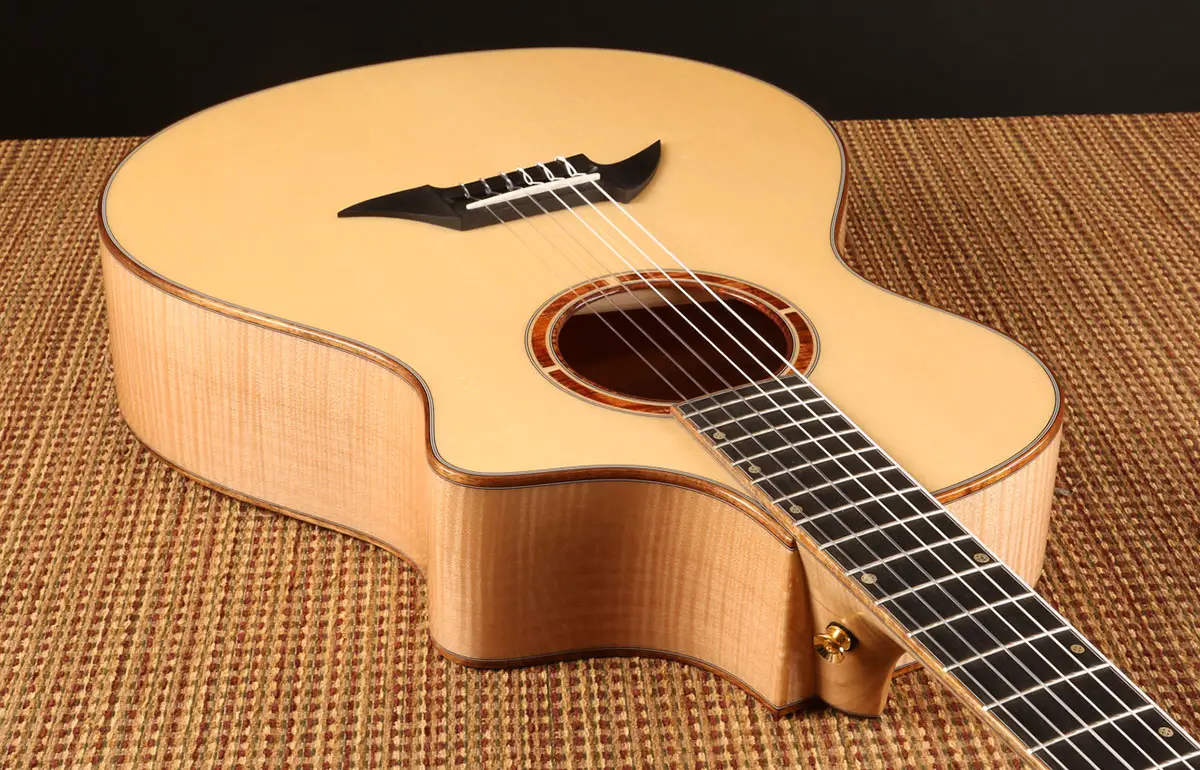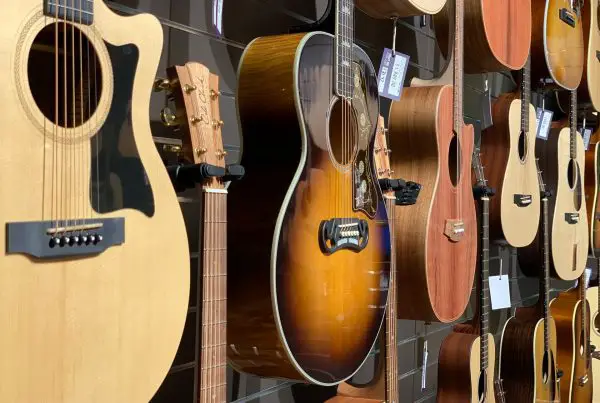When choosing the best guitar, you need to judge many aspects. Tonewood is one of them. The tonewood of the guitar affects the feel and the playing comfort. It also plays an important role in the overall tone.
It is quite natural to get confused before buying your first guitar. Nearly every guitarist has gone through this phase. If you are here, you must be seeking some advice on maple tonewood, right?
Well, here I am writing about how maple body affects the sounds of guitar. You can rely on my 7 years old expertise. I can assure that this article will satisfy all your queries. I am going to discuss all the pros and cons of using a maple body guitar.
Maple is probably the best tonewood for the guitar. It is one of the most popular tonewoods. This tonewood is mostly famous for its smooth feel, stunning look and bright tones.
Considering the tonal quality, the maple body guitar sounds bright and clear. In addition, it provides a good sustain. If you want a brighter sound, superb sustainability, grab a Maple, my friend.
Tonewood is one of the essential factors for your guitar. It affects the feel and comfort while playing it. Most importantly, it is vital for the tonal quality of your guitar. Let’s discuss maple tonewood in detail, beginning with some background of the wood.
Note: If you are interested in comparisons of maple tonewood with others, you can check out my articles below here: Guitar Body Showdown: Maple or Rosewood? (Sound, Weight, Cost)
Maple wood: Explained
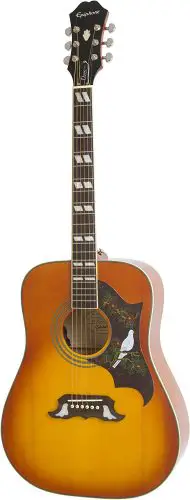
Epiphone Dove Maple Guitar
Maple is a hard and dense wood with a fine texture and straight grains. Many varieties of Maple are found. However, the Hard Maple is widely popular. It is mostly used for making guitar bodies, fretboards and necks. The hardness of Maple decides its use in making musical instruments.
Here’s a summary table about maple wood (if you don’t have the time to read through all of the details).
| Maple Wood Characteristic | Review |
| Tone |
|
| Sustain | Higher sustainable tone |
| Density | 700 kg per metre cube to 800 kg per meter cube |
| Weight |
|
| Hardness |
|
| Feel |
|
| Cost | Medium – High |
| Popularity | Second most popular tonewood for guitar |
Is Maple a Popular Wood?
Maple wood is a very popular wood. It is quite hard, dense, and resistant to damage. Due to its fine look, it is used for many purposes. You can use it in flooring, making furniture and musical instruments.
Maple body instruments like guitars are very popular. This popularity has happened due to their sound and quality.
The specialty of Maple Wood for Guitar:
- Great tonal quality: Maple body guitars sound bright, clear, and punchy. It also produces longer sustainability for more expressive tones.
- Hard wood: Maple is a dense and hard wood. It is resistant to dame. That is why it is a popular choice for making long-lasting guitars.
- Smooth feel: Maple body guitar feels smooth after finishing. Moreover, it is quite easy to work with.
- Great look: Maple wood is white to reddish brown in color. It makes a stunning appearance. Hardly does a guitarist not want his guitar eye-grabbing, right?
Aside from this there are lots of aspects left to discuss. I have just introduced you to the Maple body guitar. Now, I will discuss all those aspects in detail.
Is Maple Wood Guitar Expensive?
Maple body guitars provide varieties of price ranges. You can find dozens of maple guitars between medium to higher price ranges. However, it is quite hard to find an entry-level guitar made of Maple wood.
Maple Wood: The Pros & Cons Summarized
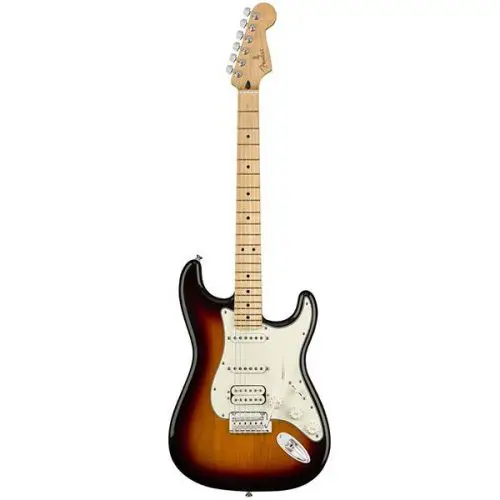
Maple is a popular choice for both acoustic and electric guitars.
We will discuss all the aspects behind Maple’s popularity as a tonewood for guitar. But, let’s have a glance first at the pros and cons of it. That will help you to understand the further part of this article.
Pros:
- Maple is a hard and dense wood.
- It has straight grains and a fine texture.
- Maple is resistant to damage.
- It is white to reddish brown in color.
- The maple is uniformly colored.
- Maple looks surprisingly well after finishing.
Cons:
- Maple is a heavy wood.
- It is a little bit expensive.
Is Maple A Good Tonewood For Guitar Body?
Tone: Maple Guitar Body
A guitar with maple wood produces a good sound. It is a hard and dense wood. So, it produces bright and clear sound with a longer sustain. The high end of a maple body guitar is clear and punchy. But, the low end sounds tight.
The tonal quality of Maple Body Guitar at a glance:
- Bright, punchy, and clear.
- Superb sustain.
- Bright and clear high ends.
- Tight low ends.
- Perfectly suits the rock or hard rock genres.
In both acoustic and electric guitar, tonewood has a key role on the tone of a guitar. However, it affects the tone of an acoustic guitar more. For electric guitars, you must consider other factors. They are the bridge, pick-ups, sound processor, and the amplifier.
Maple is a good tonewood for both acoustic and electric guitars. I have already said that I have my maple body guitar for more than 15 years. Yes, I am using both acoustic and electric guitars. Both have satisfied my taste in music, surprisingly.
How do Maple Body Acoustic Guitars Sound?
Maple body acoustic guitars sound very clear and bright. Even longer sustainability of notes can easily be found in maple-body acoustic guitars.
The tone of an acoustic guitar greatly depends on the tonewood. That is why it is quite essential to choose the best tonewood. Keep in mind that it should be according to your taste in music.
I have been using a maple body acoustic for more than decades. I mainly used it in playing rhythms and expressive solos. Whenever a clear tone is needed, I use my acoustic maple body guitar. I really love the bright and sustainable sound of this guitar.
Here is the link to a popular video that will help you to feel the brightness and sustain of a maple body acoustic guitar.
How do Maple Body Electric Guitars Sound?
Maple body electric guitars also sound brighter, punchy, and clearer. They are surprisingly good at producing sustainable tones.
Unlike acoustic guitar, many other factors contribute to deciding the tone of an electric guitar. But this does not mean that tonewood does not affect their sound.
Presently I am using a Fender guitar made of Maple. It really produces punchy and bright tones with great sustain. Moreover, the punchy high ends and tight low ends exactly fit my kind of music, hard rock.
I use a Marshall Amplifier, which does justice to my guitar. It exactly amplifies the sound that my guitar produces.
Here is the link to a popular video that will help you to feel the brightness and sustain of a maple body electric guitar.
Sustain: Maple Guitar Body
Maple body guitars are known for their long sustain. Maple is a dense wood. The density of tonewood is directly linked with the sustain of the guitar. That is why maple body guitars produce superb sustain.
In the case of an electric guitar, the sustainability of notes depends on tonewood, amplifier, and sound processors. Through a sound processor or amplifier, you can set the sustain of notes.
Maple does its magic in improving its sustainability of tones. In the case of electric guitar too, maple produces a higher sustain.
If you compare a maple body acoustic and electric guitar in terms of sustain of notes, they differ a bit from each other. Tonal quality and sustain of an acoustic guitar solely depend on the tonewood and the quality of strings.
That is why maple body acoustic guitars produce the best sustain than any other acoustic guitar.
I am a lead guitarist belonging to the hard rock genre. A brighter and more sustained tone is what I need for my solos. That is what my maple body guitar exactly provides me.
If you are looking for the best guitar for the rock genre, the maple body guitar suits you the best. Its punchy, bright, and sustained tone perfectly satisfies your taste in music.
Density: Maple Guitar Body
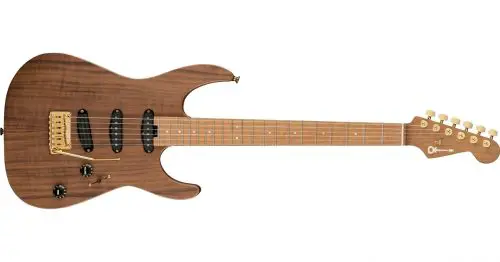
Guitars made from maple body is generally hard and durable.
Maple is a dense and hard wood. Due to the higher density of maple, it produces a bright and clear tone. Moreover, its density contributes to providing higher sustainability of notes.
Generally, Hard Maple is used in making guitars and musical instruments. Its density ranges from around 700 kilograms per meter cube to 800 kilograms per meter cube. The density of the tonewood determines the tonal quality of the guitar.
If you belong to the hard rock genre, your need is a bright, punchy, and sustained tone. That is why a dense tonewood like maple should be your top priority.
Weight: Maple Guitar Body
Maple guitars are on the heavier side because of the higher density of maple wood. The average weight of maple body electric guitars ranges from 3.5 – 4.5 kilograms. In the case of maple body acoustic guitars, the average weight ranges between 1.5 – 2 kilograms.
The comfortable weight of a guitar must be between 3 kilograms to 4 kilograms. This means that some maple body guitars may be higher in weight than the comfortable range.
The weight of your guitar is a key factor to be considered for choosing the best guitar for you. When you are playing guitars in the studio, weight does not affect you a lot.
But in the case of live performances, heavier guitars may create some trouble. Yes, the extra weight of the guitar may cause neck pain and affect your playing.
I have been using a Fender maple body guitar which weighs around 4.3 kilograms. Nowadays, I am used to the heavy weight of my guitars even during live performances.
But in the initial days, it really put me in an uncomfortable situation. However, to me, its punchy tone exceeded my feeling of neck pain.
Hardness: Maple Guitar Body
Maple is a hard wood. Hard Maple, which is generally used in making guitars, is resistant to damage. This makes the guitars long-lasting and durable.
- Janka Hardness Rating of Maple: 1500
Hard and dense tonewood increases the life of your guitar. Its hardness protects your instrument from damage.
My maple body guitars are quite hard and durable. I often travel with them and have been using them for more than years. They are performing well. However, I also take some extra precautions to protect my guitar from damage. Here is what I do.
- Use a soft padded hard case to protect the guitars from external pressure.
- Keep them clean.
- Use lemon oil at regular intervals.
- Change the strings of your guitars every 3 months.
Apart from the hardness of maple, these precautionary measures increase the life of my guitars too.
Feel: Maple Guitar Body
The maple body guitar feels solid and smooth in hand. The heaviness of these guitars may be a little troublesome. On the other hand, it looks surprisingly good.
I have been using a maple body guitar for more than 15 years. My guitar feels solid due to its hardness and density. It also felt smooth after finishing as maple has straight grains and a fine texture.
Its reddish-brown color makes my guitar more classy and attractive. However, my guitar is quite heavy (Around 4.3 kilograms). If you desire an eye-grabbing guitar with a bright and punchy tone, a maple body guitar is your need.
Cost: Maple Guitar Body
Maple wood can be expensive but it offers varieties of price ranges – generally from mid to high prices.
The price of a guitar depends on many other aspects such as the pick-ups, bridges, and other parts. Also, where it is produced contributes to determining the cost. If the guitar is imported, the import duty of your country may increase its cost.
At present, I am using a fender maple body guitar which I bought around 5 years ago. At that time my guitar cost me around $500.
Popularity: Maple Guitar Body
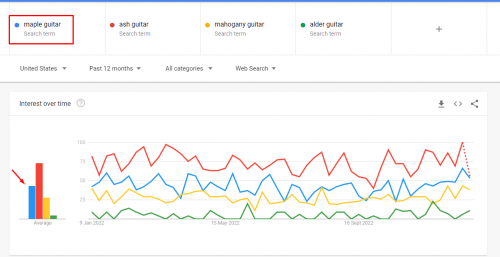
Maple is second most popular guitar behind ash.
Maple body guitar is the second most popular tonewood for guitar. Ash body guitars come first because of their more easy to use features. However, Maple guitars are the most stunning guitars in the market.
Maple is one of the most popular tonewoods. Maple comes second in this popularity chart. For features and durability, Maple body guitars step ahead of Mahogany and Alder body guitars.
The bright, punchy, and sustained tones are the key factors behind its popularity. Moreover, it has durability, attractive looks, and a varied price range. These factors also contribute to making it the second-best choice for guitar tonewoods.
Popular Companies That Use Maple To Create Guitars
Many popular companies such as Fender, EVH and Jackson use maple as tonewood (either on the body, neck or fretboard). Here are some of these popular companies and their popular maple body guitar models.
Verdict: Should You Get Guitar With Maple Body?
Maple is a great tonewood for guitars and you should definitely get it if you have been thinking about it. Maple will deliver great tones and durability but you cannot find it on entry level guitars (only mid – high range).
So, if you have the budget and have been thinking about maple guitars, go for it! You will not be wrong.
Best Guitar With Maple Body
I personally own and enjoy the Epiphone Dove guitar – it’s totally made of maple from the body, neck and fretboard. It was $450 when I bought it from Amazon (4 years ago).

Epiphone Dove Maple Guitar


